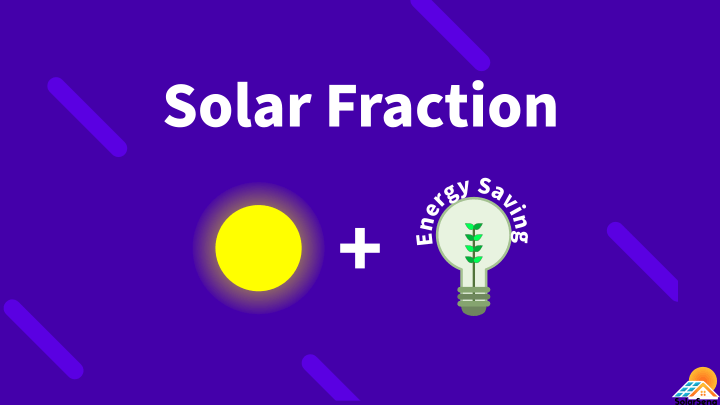Many people are using solar technology to reduce their energy demands. But for most, solar technology is still partly contributing to their energy needs. So, how does one measure to what extent solar fulfill their energy demands? Well, the answer is the solar fraction.
What is the solar fraction?
The solar fraction is the ratio of the energy provided by a solar system to the total energy required for a specific application. Since the solar fraction tells us how much utility energy we save using the solar system, it is also called the solar saving fraction.
It is a unitless quantity and is expressed in percentages.
The solar fraction equal to one means all energy requirements of an appliance is met by solar technology. Thus, your system is not dependent on nonrenewables. On the other hand, when the solar fraction is zero, it means the appliance uses zero solar energy.
We use this concept more frequently in solar thermal technology than photovoltaic.
Solar fraction and Efficiency
The solar fraction should not be confused with efficiency. Both are of different quantities. The solar fraction is the ratio of the solar energy input to your energy demands, while the efficiency of the solar system tells how effectively solar energy conversion takes place.
For the high-efficiency solar system, energy conversion is high. Solar energy will contribute more to your energy demands. As a result, your solar saving fraction will increase. In simple words, the more efficiency, the more solar fraction.
However, it is possible to have a low solar fraction with an efficient solar system. It happens when your energy needs far exceed the energy provided by solar.
Factors that affect the solar fraction
There are many factors that affect the solar fraction. Some of them are mentioned below.
Thermal collectors
Solar thermal collectors absorb sunlight and produce heat. The amount of solar energy absorbed is directly proportional to the total collector area. As the number of collectors in a solar thermal system increases, the contribution of solar energy increases. Consequently, solar fraction increases. A typical graph of the solar fraction and the area of collectors is figured below.

From the above graph, at lower values of the area, the solar fraction shows significant improvements. But as the solar fraction approaches unity, the collectors do not have much impact on the solar fraction.
Load
The total amount of energy used for heating has an inverse relationship with the solar saving fraction. If your heating load is very high, your solar fraction is obviously going to be less. For example, homes in colder regions clearly require more energy for heating, and so their solar fraction will be less compared to homes located in hotter zones.
Storage size
Another factor that influences the solar fraction is the storage size of the tank. As the volume of the storage tank increases, the solar fraction normally increases since we can now store more solar energy in the system. However, it can also decrease depending on the characteristics of the system.
Seasons and weather
The availability of the sun is seasonal and weather dependent. In the summer season, we have a clear sky and bright sun. Because of that, the solar irradiance is maximum in this portion of the year. Undesirable weather conditions, like rain, fog, hail, block the sunlight and decrease the intensity of falling solar energy. These have a major influence on the production of thermal energy and the solar fraction. The chart below depicts the same.

As the above bar graph explains, the contribution of solar energy is highest in the months of summer—June, July, and August. In the rest part of the year, the solar fraction is comparatively quite low.
Geographical location
The earth is very big and has diverse geography. The distribution of solar energy is uneven across the globe. Countries closer to the equator have more solar potential than countries closer to the poles. Usually, the solar irradiance—solar power per unit area—decreases with the latitude.
This lack of uniformity causes the solar fraction of the same thermal heating system to be different at different locations on the earth. For example, we will see a sizable difference in the solar fraction between California and Massachusetts. California is rich in the sun compared to Massachusetts. So, the same solar thermal system will produce more thermal energy in California.
Sizing
In sizing the heating system, we have to determine the solar fraction. The higher values of the solar fraction are desirable since the end-user will save money on fuels and electricity. But it also increases the cost of equipment (Capital costs) and increases the payback period. Considering the economics of the project, designers rarely size heating systems with 100% solar fraction. In practice, you will find the values between 30% to 70%.
